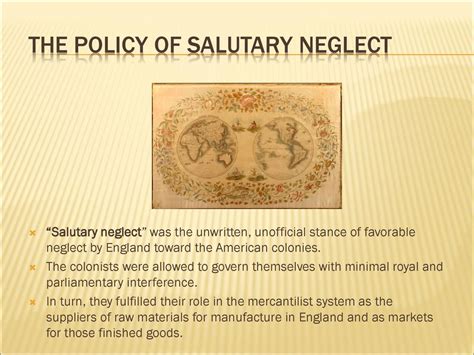Introduction
Salutary neglect was an unofficial policy adopted by the British government towards its colonies in North America. It was a period of relative autonomy and self-governance for the colonies, which lasted from the mid-17th century to the mid-18th century. This policy had a profound impact on the development of the colonies and laid the foundation for the American Revolution.

Historical Context
The policy of salutary neglect emerged as a practical response to the challenges of governing a vast and rapidly growing colonial empire. The British government faced significant geographical, political, and financial constraints in its efforts to exert control over the colonies.
The colonies were geographically dispersed and separated by vast distances. The Atlantic Ocean made communication and transportation slow and difficult. This made it challenging for the British government to enforce its laws and regulations effectively.
Moreover, the colonies had their own political and social structures. They had developed representative assemblies and local governments that asserted a degree of autonomy. The British government recognized the importance of respecting these local institutions in order to maintain stability and avoid conflicts.
Key Characteristics of Salutary Neglect
Salutary neglect was characterized by several key features:
- Limited British interference: The British government refrained from interfering in the internal affairs of the colonies. The colonies were allowed to make their own laws, establish their own governments, and develop their own economic policies.
- Lack of enforcement: The British government rarely enforced its laws and regulations in the colonies. This allowed the colonists to develop their own customs and practices without fear of reprisal.
- Economic freedom: The colonies were granted a large degree of economic freedom. They were allowed to trade with other countries and were not subject to the same trade restrictions as other British colonies.
Impact on Colonial Development
Salutary neglect had a profound impact on the development of the colonies. It allowed the colonists to develop their own political, economic, and social institutions without significant interference from the British government.
Political Development: The colonies developed strong representative assemblies that became the foundation for democratic government in America. The experience of self-governance fostered a sense of independence and autonomy among the colonists.
Economic Development: The colonies experienced rapid economic growth under salutary neglect. The lack of trade restrictions allowed them to develop industries, agriculture, and commerce. The colonies became increasingly prosperous and self-sufficient.
Social Development: The colonies developed their own unique social and cultural identities. They established schools, churches, and other institutions that shaped their values and beliefs.
The End of Salutary Neglect
The policy of salutary neglect came to an end in the mid-18th century. The French and Indian War (1754-1763) placed a significant financial burden on the British government. In an effort to recoup these costs, the British government began to assert greater control over the colonies.
The passage of the Stamp Act in 1765 was a watershed moment in the relationship between the colonies and the British government. The act imposed a tax on all printed materials in the colonies. The colonists saw this tax as an infringement on their rights and protested vigorously.
The British government’s response to these protests was to increase its military presence in the colonies and enforce its laws more aggressively. This led to a series of conflicts that culminated in the American Revolution.
Conclusion
Salutary neglect was a pivotal policy that shaped the development of colonial America. It allowed the colonies to develop their own political, economic, and social institutions without significant interference from the British government. This policy laid the foundation for the American Revolution, which ultimately led to the establishment of an independent United States of America.
FAQs
1. What were the key characteristics of salutary neglect?
- Limited British interference
- Lack of enforcement
- Economic freedom
2. What was the impact of salutary neglect on colonial development?
- Political development: strong representative assemblies
- Economic development: rapid economic growth
- Social development: unique social and cultural identities
3. Why did the policy of salutary neglect end?
- The French and Indian War placed a financial burden on the British government.
- The British government sought to recoup these costs by asserting greater control over the colonies.
4. What was the Stamp Act?
- A tax imposed by the British government on all printed materials in the colonies.
- This tax was seen as an infringement on the rights of the colonists and sparked protests.
5. What was the British government’s response to the protests against the Stamp Act?
- Increased military presence in the colonies
- Aggressive enforcement of laws
6. What was the ultimate outcome of the British government’s response to the protestas against the Stamp Act?
- The American Revolution
